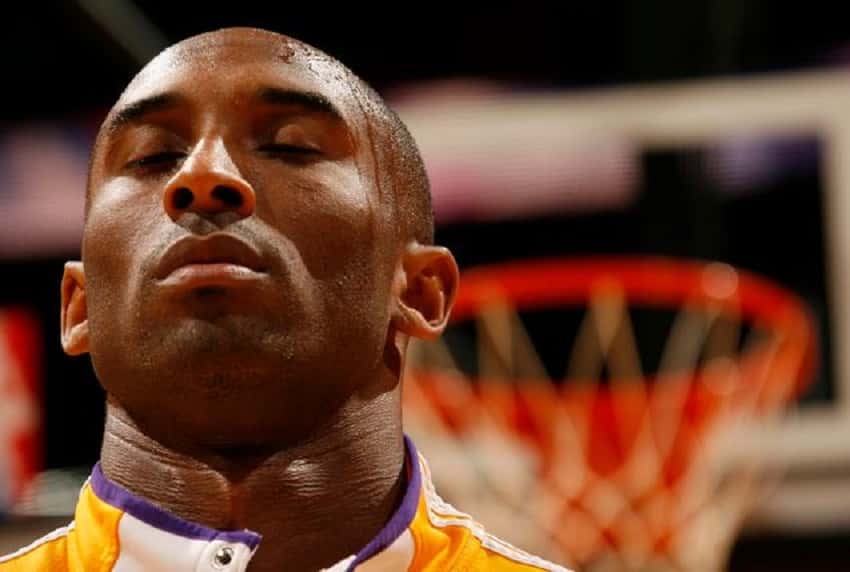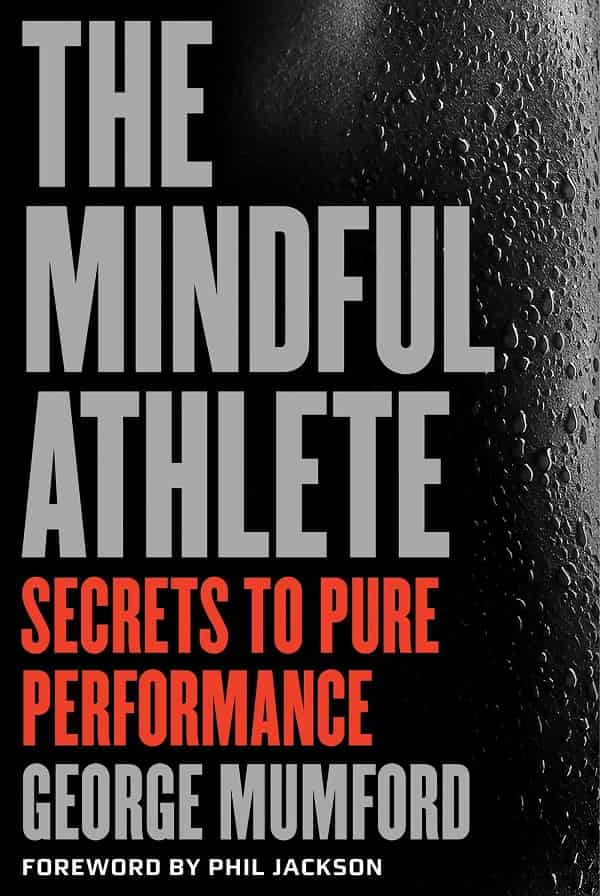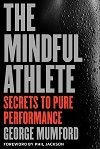
The Mindful Athlete by George Mumford is a blueprint for mindfulness to improve athletic performance. Mumford has consulted with Phil Jackson during his coaching years, working with Michael Jordan, Scottie Pippen, the late Kobe Bryant, Shaquille O’Neill, and more.
I absolutely love The Mindful Athlete.
I picked it up, expecting a quick intro and guide to mindfulness. Maybe a guided script or something.
Nope.
Instead, Mumford takes the reader gently down the path of a greater understanding of your mindset. The revelations along the way—that our thoughts are generally running amok, we breathe improperly, we mishandle negative emotions—might not be a grand shock, but the way Mumford sheds light on how mindfulness can straighten those thoughts out is warm and empowering.
By the end of the book it is difficult not to imagine much improved athletic performance, both in training and in competition.
Mumford traces his journey from aspiring athlete (he played with Dr J as a youth) to battling addiction. It was while he was struggling to overcome his addiction that his work’s HMO offered a stress management program, which was essentially mindfulness. He started practicing yoga and meditation, and as the layers peeled back, he found a greater and deeper understanding with himself.
“It was a slow but powerful revelation. I learned to listen to my body,” writes Mumford. Instead of trying to paper over the pain he was feeling with drugs, he “began to look for its cause, treat it gently, and adapt my behaviors to take care of it rather than hide it.”
Mumford guides the reader through mindfulness, its components, and just how much of an impact it can have on an athlete and the human being under the jersey.
He touches on a ton of things: the dramatic impact of visualization and mental rehearsal, the importance of coming to accept your suffering and burdens in life so that you can work through them, and provides key summaries with each section to distill the material.
There is research and science sprinkled throughout to support key concepts which pulls back the moments where it may feel like Mumford is close to slipping into hokey, “soft woo woo” territory.
Mumford covers a great deal of ground, showcasing just how versatile this tool can be for high performance athletes. Deliberate practice, being still in the midst of high-pressure situations, managing the anxiety and uncertainty of injury, and more.
This was a life changing book, and is one of my top mental toughness books for athletes or even when I get recommendations for my favorite sport psychology book. If you are looking to sharpen your mental game, this book is required reading.
Below is just a taste of the key quotes and passages, as well as some of my own notes on Mumford’s book.

Where to Buy The Mindful Athlete: Secrets to Pure Performance
“I don’t know why it often takes a crisis or a fastball from the universe knocking us off our feet for us to finally have our ass on fire enough to act. Maybe it’s a flaw in the human condition, or maybe it’s simply part of the human condition… the gift of desperation compels us to move forward. Without fire in our lives, we sometimes don’t have the internal combustion necessary to change and take risks.”
“Taking small steps, consistently, in the right direction will eventually yield big results. This is one of the most simple and profound truths in life. You have to start taking baby steps, even though you know you’ll fall down.”
Around 1991, Mumford was asked by Phil Jackson, head coach of the Chicago Bulls (and author of the excellent leadership book, 11 Rings: The Soul of Success), to work with his team, including the GOAT, Michael Jordan. Mumford had found his calling, combining his passion for mindfulness and athletics. “…as Michael Jordan suggested, ‘that Zen Buddhist stuff’ really works.”
When it comes to being a mindful athlete, there are “five superpowers”: Mindfulness, concentration, insight, right effort, and trust.
“Being a mindful athlete involves living this truth for yourself, because there is no separating who you are on the court, field, or yoga mat from who you are in the world at large.”
“Mindfulness helps you pay attention to your thoughts in a nonattached manner, which often takes the emotional charge out of them, slows down your experience of time, and reconnects you to the present moment.”
“The mind is a muscle. You need to take care of it through daily practice. It’s that simple and that profound.”
“Life is all about the stimulus that we experience in the world and the way we interpret that in our minds.”
“We can react to this stimulus in various knee-jerk ways—with anger, agitation, anxiety, fear, craving, doubt, guilt—or we can respond to this stimulus by getting still, paying attention ‘on purpose’ to what thoughts and feelings come up within ourselves without judgment, and acting from this center space of calm.”
“This calm center space is what anchors the mindful athlete in the present moment and facilitates high performance and flow.”
“Mindfulness is awareness of the totality of the present moment.”
“We tend to dwell myopically on the problem in front of us. We think that’s all there is.”
“Mindfulness is a practice. Not a destination.”
“It is almost as if you step away from yourself and observe yourself in the moment… You stay with the experience of the emotion in the present moment by being aware of it rather than reacting to it and getting swept away by it.”
“When you practice mindfulness, you become aware that there is a huge difference between being aware that you are angry or anxious, and being mindful of your anger or your anxiety. To be mindful of your anger or anxiety, you must be aware of yourself ‘on purpose’ and observe your reactions to things in a nonattached way, as if you were observing yourself from outside of yourself.”
“Respond from the center of the hurricane, rather than reacting from the chaos of the storm.”
We have become a society of shallow breathers. “When we’re stressed, our breathing becomes even shallower, which makes us even more prone to stress.”
“When you get in the Zone, things just slow down. Everything slows down. You have supreme confidence. When that happens, you really do not try to focus on what’s going (around you) because out there (in the crowd), you could lose it in a second. Everything becomes one noise. You’re not paying attention to this or that noise. You have to really try to stay in the present, not let anything break that rhythm. You just stay here. You’re kind of locked in.” – Kobe Bryant
“The brain doesn’t know the difference between what we think and what we experience. So if we imagine or think about something related to the past or the future, on some level we will experience that event—including all the emotions it provokes.”
“When you get very still and focused on the present moment, and you recreate in your mind an experience that you want to recreate outside yourself (or outcome expectation)—you’re doing two things: you’re mentally rehearsing those things, and you’re also learning these things in your body. This is a very different kind of learning from the fitful, fretful focus on winning.”
If training is boring, “then you’ve got to examine your commitment, intention, and the concentration behind it. It’s only by doing repetitions that we learn.”
“For some elite athletes it’s not even a question of will; they love to get out of their comfort zones and thrive on pressure. That was one of Michael Jordan’s defining characteristics: how much joy he could find in being in a challenging, pressure-filled situation.”
“Sometimes we can become so attached to our suffering that we actually identify with it. Without our suffering, we don’t know who we are, and so we unconsciously cling to it.”
“Basically, what I’m suggesting is that we all have our personal form of suffering. Suffering is a part of life and there’s no way of avoiding it. If we want to evolve as human being, we have to understand the wisdom that’s hidden in this suffering—and that includes knowing what is feeding this suffering—and commit to a path that leads us out of suffering.”
“Sometimes the way we release stress can the very thing that creates it: emotional eating, boozing, spacing out, competing with aggression instead of love for the game.”
“In many ways, mindfulness practice is about letting go. I’m not talking about letting go of pleasant experiences. I’m talking about letting go of conditioned responses that don’t serve us, even when we love those conditioned responses dearly.”
In the same way that you can physically train the body to withstand harder workouts, faster intervals, and heavier weights, “Mentally we can train ourselves to be comfortable with being uncomfortable, to feel calm in the midst of chaos and stay in the eye of the proverbial hurricane.”
 Where to Buy The Mindful Athlete: Secrets to Pure Performance
Where to Buy The Mindful Athlete: Secrets to Pure Performance
Want more stuff like this:
View my favorite leadership books for coaches here.
I also have an essential reading list for athletes. You can check out this list of my favorite mental toughness books for athletes.